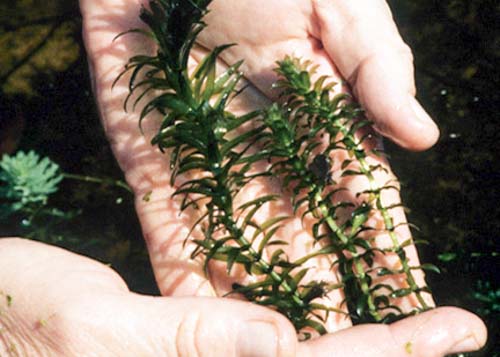Brazilian Elodea
Invasive Brazilian elodea (Egeria densa) is a canopy former, so if you can get a bait through the top, there are many openings below that can hold big fish. Tie on some heavy tungsten and do your best to get down to the fish.

Seasonal Techniques
Spring—Acting much like an evergreen, this species will come back from existing plants in spring and even begin flowering in late spring. Brazilian elodea will grow rapidly, often creating some of the first large mats to fish. Fish a swimbait around clearly defined weed edges.
Summer—Invasive Brazilian elodea will begin growing profusely during summer, creating dense, tangled mats on the water’s surface. Dense mat formation will make fishing Brazilian elodea tough. Tie on some heavy tungsten and do your best to get a bait down to the fish. This species is a canopy former, so if you can get a bait through the top, there are many openings below that can hold big fish.
Fall—Brazilian elodea will briefly begin another flush of growth in fall while other plants are beginning to die back, also beginning a second cycle of flowering. A second growth spurt will mean that this plant will still be growing while others are not. Brazlian elodea can hold that frog bite much later into the fall and early winter while others mats are breaking up.
Winter—Plants will persist throughout winter as dormant root crowns. Hanging around through winter, Brazilian elodea can provide some structure while many other plants will be gone until spring.
Habitat Value
Fish—Brazilian elodea forms large colonies, especially along the main river channel, which offer an open understory for fish.
Waterfowl—N/A
Identifying Features
What It Looks Like—Leaves are large, pointed and whorled around the stem, often appearing dark green or even purple.
Where to Find It—Look for Brazilian elodea on main lake points and along the river where flow is increased. Long linear beds of the plant seem to always show up in the riverine section of the reservoirs in which it exists.
Max Depth—0 to 10 feet
Similar Species—Brazilian elodea looks very similar to hydrilla; however hydrilla leaves have teeth that can be seen with the naked eye and Brazilian elodea is typically much larger than hydrilla in appearance. Canadian elodea is also similar but much smaller and more “whimpy” looking.
Drawbacks
Invasive Brazilian elodea commonly causes issues with water use and is very often managed as a result. The ability of the plant to spread and rapidly grow makes it very expensive to manage. Cost to manage: $$$$ out of $$$$$.
Contact Us
We're always looking for more information about aquatic plants on TVA reservoirs. Let us know where and what you see, and send us your photos. Email us.